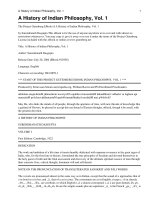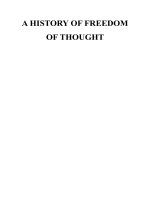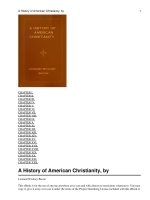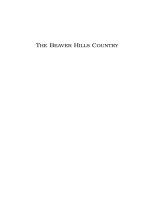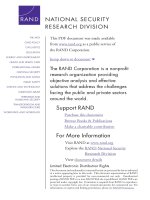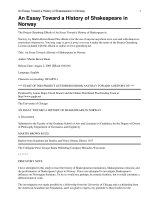a history of mathematics
Bạn đang xem bản rút gọn của tài liệu. Xem và tải ngay bản đầy đủ của tài liệu tại đây (5.95 MB, 690 trang )
A
History
of
Mathematics
THIRD EDITION
Uta C. Merzbach and Carl B. Boyer
John Wiley & Sons, Inc.
Copyright r 1968, 1989, 1991, 2011 by John Wiley & Sons, Inc. All rights reserved
Published by John Wiley & Sons, Inc., Hoboken, New Jersey
Published simultaneously in Canada
No part of this publication may be reproduced, stored in a retrieval system, or trans
mitted in any form or by any means, electronic, mechanical, photocopying, recording,
scanning, or otherwise, except as permitted under Section 107 or 108 of the 1976
United States Copyright Act, without either the prior written permission of the Pub
lisher, or authorization through payment of the appropriate per copy fee to the
Copyright Clearance Center, 222 Rosewood Drive, Danvers, MA 01923, (978)
750 8400, fax (978) 646 8600, or on the web at www.copyright.com. Requests to the
Publisher for permission should be addressed to the Permissions Department, John
Wiley & Sons, Inc., 111 River Street, Hoboken, NJ 07030, (201) 748 6011, fax (201)
748 6008, or online at />Limit of Liability/Disclaimer of Warranty: While the publisher and author have
used their best efforts in preparing this book, they make no representations or war
ranties with respect to the accuracy or completeness of the contents of this book and
specifically disclaim any implied warranties of merchantability or fitness for a par
ticular purpose. No warranty may be created or extended by sales representatives or
written sales materials. The advice and strategies contained herein may not be suit
able for your situation. You should consult with a professional where appropriate.
Neither the publisher nor author shall be liable for any loss of profit or any other
commercial damages, including but not limited to special, incidental, consequential,
or other damages.
For general information about our other products and services, please contact our
Customer Care Department within the United States at (800) 762 2974, outside the
United States at (317) 572 3993 or fax (317) 572 4002.
Wiley also publishes its books in a variety of electronic formats. Some content that
appears in print may not be available in electronic formats. For more information
about Wiley products, visit our web site at www.wiley.com.
Library of Congress Cataloging-in-Publication Data:
Boyer, Carl B. (Carl Benjamin), 1906À1976.
A history of mathematics / Carl B. Boyer and Uta Merzbach. 3rd ed.
p. cm.
Includes bibliographical references and index.
ISBN 978 0 470 52548 7 (pbk.); ISBN 978 0 470 63039 6 (ebk.);
ISBN 978 0 470 63054 9 (ebk.); ISBN 978 0 470 630563 (ebk.)
1. Mathematics History. I. Merzbach, Uta C., 1933À II. Title.
QA21.B767 2010
510.9 dc22 2010003424
Printed in the United States of America
10987654321
In memory of Carl B. Boyer
(1906À1976)
U.C.M.
To the memory of my parents,
Howard Franklin Boyer and
Rebecca Catherine (Eisenhart) Boyer
C.B.B.
Contents
Foreword by Isaac Asimov, xi
Preface to the Third Edition, xiii
Preface to the Second Edition, xv
Preface to the First Edition, xvii
1 Traces 1
Concepts and Relationships, 1 Early Number Bases, 3
Number Language and Counting, 5 Spatial Relationships, 6
2 Ancient Egypt 8
The Era and the Sources, 8 Numbers and Fractions, 10
Arithmetic Operations, 12 “Heap” Problems, 13 Geometric
Problems, 14 Slope Problems, 18 Arithmetic Pragmatism, 19
3 Mesopotamia 21
The Era and the Sources, 21 Cuneiform Writing, 22
Numbers and Fractions: Sexagesimals, 23 Positional
Numeration, 23 Sexagesimal Fractions, 25 Approximations, 25
Tables, 26 Equations, 28 Measurements: Pythagorean
Triads, 31 Polygonal Areas, 35 Geometry as Applied
Arithmetic, 36
4 Hellenic Traditions 40
The Era and the Sources, 40 Thales and Pythagoras, 42
Numeration, 52 Arithmetic and Logistic, 55
v
Fifth-Century Athens, 56 Three Classical Problems, 57
Quadrature of Lunes, 58 Hippias of Elis, 61 Philolaus
and Archytas of Tarentum, 63 Incommensurability, 65
Paradoxes of Zeno, 67 Deductive Reasoning, 70
Democritus of Abdera, 72 Mathematics and the Liberal Arts, 74
The Academy, 74 Aristotle, 88
5 Euclid of Alexandria 90
Alexandria, 90 Lost Works, 91 Extant Works, 91
The Elements,93
6 Archimedes of Syracuse 109
The Siege of Syracuse, 109 On the Equilibriums of Planes, 110
On Floating Bodies, 111 The Sand-Reckone r, 112
Measurement of the Circle , 113 On Spirals, 113
Quadrature of the Parabola , 115 On Conoids and Spheroids, 116
On the Sphere and Cylinder, 118 Book of Lemmas, 120
Semiregular Solids and Trigonometry, 121 The Method, 122
7 Apollonius of Perge 127
Works and Tradition, 127 Lost Works, 128 Cycles
and Epicycles, 129 The Conics, 130
8 Crosscurrents 142
Changing Trends, 142 Eratosthenes, 143 Angles and
Chords, 144 Ptolemy’s Almagest, 149 Heron of Alexandria, 156
The Decline of Greek Mathematics, 159 Nicomachus of
Gerasa, 159 Diophantus of Alexandria, 160 Pappus of
Alexandria, 164 The End of Alexandrian Domi nance, 170
Proclus of Alexandria, 171 Boethius, 171
Athenian Fragments, 172 Byzantine Mathematicians, 173
9 Ancient and Medieval China 175
The Oldest Known Texts, 175 The Nine Chapters, 176
Rod Numerals, 177 The Abacus and Decimal Fractions, 178
Values of Pi, 180 Thirteenth-Century Mathematics, 182
10 Ancient and Medieval India 186
Early Mathematics in India, 186 The Sulbasutras, 187
The Siddhantas, 188 Aryabhata, 189 Numerals, 191
Trigonometry, 193 Multiplication, 194 Long Division, 195
Brahmagupta, 197 Indeterminate Equations, 199 Bhaskara, 200
Madhava and the Keralese School, 202
vi Contents
11 The Islamic Hegemony 203
Arabic Conquests, 203 The House of Wisdom, 205
Al-Khwarizmi, 206 ‘Abd Al-Hamid ibn-Turk, 212
Thabit ibn-Qurra, 213 Numerals, 214 Trigonometry, 216
Tenth- and Eleventh-Century Highlights, 216
Omar Khay yam, 218 The Parallel Postulate, 220
Nasir al-Din al-Tusi, 220 Al-Kashi, 221
12 The Latin West 223
Introduction, 223 Compendia of the Dark Ages, 224
Gerbert, 224 The Century of Translation, 226 Abacists
and Algorists, 227 Fibonacci, 229 Jordanus Nemorarius, 232
Campanus of Novara, 233 Learning in the Thirteenth
Century, 235 Archimedes Revived, 235 Medieval Kinematics, 236
Thomas Bradwardine, 236 Nicole Oresme, 238 The Latitude
of Forms, 239 Infinite Series, 241 Levi ben Gerson, 242
Nicholas of Cusa, 243 The Decline of Medieval Learning, 243
13 The European Renaissance 245
Overview, 2 45 Regiomontanus, 246 Nicolas
Chuquet’s Triparty, 249 Luca Pacioli’s Summa, 251
German Algebras and Arithmetics, 253 Cardan’s Ars Magna, 255
Rafael Bombelli, 260 Robert Recorde, 262 Trigonometry, 263
Geometry, 264 Renaissance Trends, 271 Franc¸ois Vie
`
te, 273
14 Early Modern Problem Solvers 282
Accessibility of Computation, 282 Decimal Fractions, 283
Notation, 285 Logarithms, 286 Mathematical Instruments, 290
Infinitesimal Methods: Stevin, 296 Johannes Kepler, 296
15 Analysis, Synthesis, the Infinite, and Numbers 300
Galileo’s Two New Sciences , 300 Bonaventura Cavalieri, 303
Evangelista Torricelli, 306 Mersenne’s Communicants, 308
Rene
´
Descartes, 309 Fermat’s Loci, 320 Gregory of
St. Vincent, 325 The Theory of Numbers, 326
Gilles Persone de Roberval, 329 Girard Desargues and
Projective Geometry, 330 Blaise Pascal, 332 Philippe
de Lahire, 337 Georg Mohr, 338 Pietro Mengoli, 338
Frans van Schooten, 339 Jan de Witt, 340 Johann Hudde, 341
Rene
´
Franc¸ois de Sluse, 342 Christiaan Huygens, 342
16 British Techniques and Continental Methods 348
John Wallis, 348 James Gregory, 353 Nicolaus Mercator and
William Brouncker, 355 Barrow’s Method of Tangents, 356
Contents vii
Newton, 358 Abraham De Moivre, 372 Roger Cotes, 375
James Stirling, 376 Colin Maclaurin, 376 Textbooks, 380
Rigor and Progress, 381 Leibniz, 382 The Bernoulli
Family, 390 Tschirnhaus Transformations, 398 Solid
Analytic Geometry, 399 Michel Rolle and Pierre Varignon, 400
The Clairauts, 401 Mathematics in Italy, 402 The Parallel
Postulate, 403 Divergent Series, 404
17 Euler 406
The Life of Euler, 406 Notation, 408 Foundation of
Analysis, 409 Logarithms and the Euler Identities, 413
Differential Equations, 414 Probability, 416 The Theory of
Numbers, 417 Textbooks, 418 Analytic Geometry, 419
The Parallel Postulate: Lambert, 420
18 Pre to Postrevolutionary France 423
Men and Institutions, 423 The Committee on Weights
and Measures, 424 D’Alembert, 425 Be
´
zout, 427
Condorcet, 429 Lagrange, 43 0 Monge, 433 Carnot, 438
Laplace, 443 Legendre, 446 Aspects of Abstraction, 449
Paris in the 1820s, 449 Fourier, 450 Cauchy, 452
Diffusion, 46 0
19 Gauss 464
Nineteenth-Century Overview, 464 Gauss: Early Work, 465
Number Theory, 466 Reception of the Disquisi tiones
Arithmeticae, 469 Astronomy, 470 Gauss’s Middle Years, 471
Differential Geometry, 472 Gauss’s Later Work, 473
Gauss’s Influence, 474
20 Geometry 483
The School of Monge, 483 Projective Geometry: Poncelet and
Chasles, 485 Synthetic Metric Geometry: Steiner, 487
Synthetic Nonmetric Geometry: von Staudt, 489 Analytic
Geometry, 489 Non-Euclidean Geometry, 494 Riemannian
Geometry, 496 Spaces of Higher Dimensions, 498
Felix Klein, 499 Post-Riemannian Algebraic Geometry, 501
21 Algebra 504
Introduction, 504 British Algebra and the Operational
Calculus of Functions, 505 Boole and the Algebra of Logic, 506
Augustus De Morgan, 509 William Rowan Hamilton, 510
Grassmann and Ausdehnungslehre, 512 Cayley and Sylvester, 515
Linear Associative Algebras, 519 Algebraic Geometry, 520
Algebraic and Arithmetic Integers, 520 Axioms of Arithmetic, 522
viii Contents
22 Analysis 526
Berlin and Go
¨
ttingen at Midcentury, 526 Riemann in
Go
¨
ttingen, 527 Mathematical Physics in Germany, 528
Mathematical Physics in English-Speaking Countries, 529
Weierstrass and Students, 531 The Arithmetization of
Analysis, 533 Dedekind, 536 Cantor and Kronecker, 538
Analysis in France, 543
23 Twentieth Century Legacies 548
Overview, 5 48 Henri Poincare
´
, 549 David Hilbert, 555
Integration and Measure, 564 Functional Analysis and
General Topology, 568 Algebra, 570 Differential Geometry
and Tensor Analysis, 572 Probability, 573 Bounds and
Approximations, 575 The 1930s and World War II, 577
Nicolas Bourbaki, 578 Homological Algebra
and Category Theory, 580 Algebraic Geome try, 581
Logic and Computing, 582 The Fields Medals, 584
24 Recent Trends 586
Overview, 5 86 The Four-Color Conjecture, 587
Classification of Finite Simple Groups, 591 Fermat’s
Last Theorem, 593 Poincare
´
’s Query, 596 Future Outlook, 599
References, 601
General Bibliography, 633
Index, 647
Contents ix
Foreword to the Second Edition
By Isaac Asimov
Mathematics is a unique aspect of human thought, and its history differs
in essence from all other histories.
As time goes on, nearly every field of human endeavor is marked
by changes which can be considered as correction and/or extension. Thus,
the changes in the evolving history of political and military events are
always chaotic; there is no way to predict the rise of a Genghis Khan,
for example, or the consequences of the short-lived Mongol Empire.
Other changes are a matter of fashion and subjective opinion. The cave-
paintings of 25,000 years ago are generally considered great art, and while
art has continuously—even chaotically—changed in the subsequent
millennia, there are elements of greatness in all the fashions. Similarly,
each society considers its own ways natural and rational, and finds the
ways of other societies to be odd, laughable, or repulsive.
But only among the sciences is there true progress; only there is the
record one of continuous advance toward ever greater heights.
And yet, among most branches of science, the process of progress is
one of both correction and extension. Aristotle, one of the greatest minds
ever to contemplate physical laws, was quite wrong in his views on
falling bodies and had to be corrected by Galileo in the 1590s. Galen, the
greatest of ancient physicians, was not allowed to study human cadavers
and was quite wrong in his anatomical and physiological conclusions.
He had to be corrected by Vesalius in 1543 and Harvey in 1628. Even
Newton, the greatest of all scientists, was wrong in his view of the nature
of light, of the achromaticity of lenses, and missed the existence of
xi
spectral lines. His masterpiece, the laws of motion and the theory of
universal gravitation, had to be modified by Einstein in 1916.
Now we can see what makes mathematics unique. Only in mathe-
matics is there no significant correction—only extension. Once the
Greeks had developed the deductive method, they were correct in what
they did, correct for all time. Euclid was incomplete and his work has
been extended enormously, but it has not had to be corrected. His the-
orems are, every one of them, valid to this day.
Ptolemy may have developed an erroneous picture of the planetary
system, but the system of trigonometry he worked out to help him with
his calculations remains correct forever.
Each great mathematician adds to what came previously, but nothing
needs to be uprooted. Consequently, when we read a book like A History
of Mathematics, we get the picture of a mounting structure, ever taller and
broader and more beautiful and magnificent and with a foundation,
moreover, that is as untainted and as functional now as it was when
Thales worked out the first geometrical theorems nearly 26 centuries ago.
Nothing pertaining to humanity becomes us so well as mathematics.
There, and only there, do we touch the human mind at its peak.
xii Foreword to the Second Edition
Preface to the Third Edition
During the two decades since the appearance of the second edition of
this work, there have been substantial changes in the course of mathe-
matics and the treatment of its history. Within mathematics, outstanding
results were achieved by a merging of techniques and concepts from
previously distinct areas of specialization. The history of mathematics
continued to grow quantitatively, as noted in the preface to the second
edition; but here, too, there were substantial studies that overcame the
polemics of “internal” versus “external” history and combined a fresh
approach to the mathematics of the original texts with the appropriate
linguistic, sociological, and economic tools of the historian.
In this third edition I have striven again to adhere to Boyer’s approach
to the history of mathematics. Although the revision this time includes
the entire work, changes have more to do with emphasis than original
content, the obvious exception being the inclusion of new findings since
the appearance of the first edition. For example, the reader will find
greater stress placed on the fact that we deal with such a small number of
sources from antiquity; this is one of the reasons for condensing three
previous chapters dealing with the Hellenic period into one. On the other
hand, the chapter dealing with China and India has been split, as content
demands. There is greater emphasis on the recurring interplay between
pure and applied mathematics as exemplified in chapter 14. Some
reorganization is due to an attempt to underline the impact of institu-
tional and personal transmission of ideas; this has affected most of the
pre-nineteenth-century chapters. The chapters dealing with the nineteenth
century have been altered the least, as I had made substantial changes
for some of this material in the second edition. The twentieth-century
xiii
material has been doubled, and a new final chapter deals with recent
trends, including solutions of some longstanding problems and the effect
of computers on the nature of proofs.
It is always pleasant to acknowledge those known to us for having had
an impact on our work. I am most grateful to Shirley Surrette Duffy for
responding judiciously to numerous requests for stylistic advice, even at
times when there were more immediate priorities. Peggy Aldrich Kid-
well replied with unfailing precision to my inquiry concerning certain
photographs in the National Museum of American History. Jeanne
LaDuke cheerfully and promptly answered my appeals for help, espe-
cially in confirming sources. Judy and Paul Green may not realize that a
casual conversation last year led me to rethink some recent material. I
have derived special pleasure and knowledge from several recent pub-
lications, among them Klopfer 2009 and, in a more leisurely fashion,
Szpiro 2007. Great thanks are due to the editors and production team of
John Wiley & Sons who worked with me to make this edition possible:
Stephen Power, the senior editor, was unfailingly generous and diplo-
matic in his counsel; the editorial assistant, Ellen Wright, facilitated
my progress through the major steps of manuscript creation; the senior
production manager, Marcia Samuels, provided me with clear and
concise instructions, warnings, and examples; senior production editors
Kimberly Monroe-Hill and John Simko and the copyeditor, Patricia
Waldygo, subjected the manuscript to painstakingly meticulous scrutiny.
The professionalism of all concerned provides a special kind of
encouragement in troubled times.
I should like to pay tribute to two scholars whose influence on others
should not be forgotten. The Renaissance historian Marjorie N. Boyer
(Mrs. Carl B. Boyer) graciously and knowledgeably complimented
a young researcher at the beginning of her career on a talk presented at a
Leibniz conference in 1966. The brief conversation with a total stranger
did much to influence me in pondering the choice between mathematics
and its history.
More recently, the late historian of mathematics Wilbur Knorr set a
significant example to a generation of young scholars by refusing to
accept the notion that ancient authors had been studied definitively by
others. Setting aside the “magister dixit,” he showed us the wealth of
knowledge that emerges from seeking out the texts.
—Uta C. Merzbach
March 2010
xiv Preface to the Third Edition
Preface to the Second Edition
This edition brings to a new generation and a broader spectrum of
readers a book that became a standard for its subject after its initial
appearance in 1968. The years since then have been years of renewed
interest and vigorous activity in the history of mathematics. This has
been demonstrated by the appearance of numerous new publications
dealing with topics in the field, by an increase in the number of courses
on the history of mathematics, and by a steady growth over the years in
the number of popular books devoted to the subject. Lately, growing
interest in the history of mathematics has been reflected in other bran-
ches of the popular press and in the electronic media. Boyer’s con-
tribution to the history of mathematics has left its mark on all of these
endeavors.
When one of the editors of John Wiley & Sons first approached me
concerning a revision of Boyer’s standard work, we quickly agreed that
textual modifications should be kept to a minimum and that the changes
and additions should be made to conform as much as possible to Boyer’s
original approach. Accordingly, the first twenty-two chapters have been
left virtually unchanged. The chapters dealing with the nineteenth century
have been revised; the last chapter has been expanded and split into two.
Throughout, an attempt has been made to retain a consistent approach
within the volume and to adhere to Boyer’s stated aim of giving stronger
emphasis on historical elements than is customary in similar works.
The references and general bibliography have been substantially
revised. Since this work is aimed at English-speaking readers, many of
whom are unable to utilize Boyer’s foreign-language chapter references,
these have been replaced by recent works in English. Readers are urged to
xv
consult the General Bibliography as well, however. Immediately fol-
lowing the chapter references at the end of the book, it contains additional
works and further bibliographic references, with less regard to language.
The introduction to that bibliography provides some overall guidance for
further pleasurable reading and for solving problems.
The initial revision, which appeared two years ago, was designed for
classroom use. The exercises found there, and in the original edition,
have been dropped in this edition, which is aimed at readers outside the
lecture room. Users of this book interested in supplementary exercises
are referred to the suggestions in the General Bibliography.
I express my gratitude to Judith V. Grabiner and Albert Lewis for
numerous helpful criticisms and suggestions. I am pleased to acknowl-
edge the fine cooperation and assistance of several members of the
Wiley editorial staff. I owe immeasurable thanks to Virginia Beets for
lending her vision at a critical stage in the preparation of this manuscript.
Finally, thanks are due to numerous colleagues and students who have
shared their thoughts about the first edition with me. I hope they will find
beneficial results in this revision.
—Uta C. Merzbach
Georgetown, Texas
March 1991
xvi Preface to the Second Edition
Preface to the First Edition
Numerous histories of mathematics have appeared during this century,
many of them in the English language. Some are very recent, such as
J. F. Scott’s A History of Mathematics
1
; a new entry in the field,
therefore, should have characteristics not already present in the available
books. Actually, few of the histories at hand are textbooks, at least not in
the American sense of the word, and Scott’s History is not one of them.
It appeared, therefore, that there was room for a new book—one that
would meet more satisfactorily my own preferences and possibly those
of others.
The two-volume History of Mathematics by David Eugene Smith
2
was
indeed written “for the purpose of supplying teachers and students with a
usable textbook on the history of elementary mathematics,” but it covers
too wide an area on too low a mathematical level for most modern
college courses, and it is lacking in problems of varied types. Florian
Cajori’s History of Mathematics
3
still is a very helpful reference work;
but it is not adapted to classroom use, nor is E. T. Bell’s admirable
The Development of Mathematics.
4
The most successful and app-
ropriate textbook today appears to be Howard Eves, An Introduction to
the History of Mathematics,
5
which I have used with considerable
satisfaction in at least a dozen classes since it first appeared in 1953.
1
London: Taylor and Francis, 1958.
2
Boston: Ginn and Company, 1923À1925.
3
New York: Macmillan, 1931, 2nd edition.
4
New York: McGraw Hill, 1945, 2nd edition.
5
New York: Holt, Rinehart and Winston, 1964, revised edition.
xvii
I have occasionally departed from the arrangement of topics in the book
in striving toward a heightened sense of historicalmindedness and have
supplemented the material by further reference to the contributions
of the eighteenth and nineteenth centuries especially by the use of
D. J. Struik, A Concise History of Mathematics.
6
The reader of this book, whether layman, student, or teacher of a
course in the history of mathematics, will find that the level of mathe-
matical background that is presupposed is approximately that of a col-
lege junior or senior, but the material can be perused profitably also by
readers with either stronger or weaker mathematical preparation. Each
chapter ends with a set of exercises that are graded roughly into three
categories. Essay questions that are intended to indicate the reader’s
ability to organize and put into his own words the material discussed in
the chapter are listed first. Then follow relatively easy exercises that
require the proofs of some of the theorems mentioned in the chapter or
their application to varied situations. Finally, there are a few starred
exercises, which are either more difficult or require specialized methods
that may not be familiar to all students or all readers. The exercises do
not in any way form part of the general exposition and can be dis-
regarded by the reader without loss of continuity.
Here and there in the text are references to footnotes, generally bib-
liographical, and following each chapter there is a list of suggested
readings. Included are some references to the vast periodical literature in
the field, for it is not too early for students at this level to be introduced
to the wealth of material available in good libraries. Smaller college
libraries may not be able to provide all of these sources, but it is well for
a student to be aware of the larger realms of scholarship beyond the
confines of his own campus. There are references also to works in for-
eign languages, despite the fact that some students, hopefully not many,
may be unable to read any of these. Besides providing important addi-
tional sources for those who have a reading knowledge of a foreign
language, the inclusion of references in other languages may help to
break down the linguistic provincialism which, ostrichlike, takes refuge
in the mistaken impression that everything worthwhile appeared in, or
has been translated into, the English language.
The present work differs from the most successful presently available
textbook in a stricter adherence to the chronological arrangement and a
stronger emphasis on historical elements. There is always the temptation
in a class in history of mathematics to assume that the fundamental
purpose of the course is to teach mathematics. A departure from math-
ematical standards is then a mortal sin, whereas an error in history is
venial. I have striven to avoid such an attitude, and the purpose of the
6
New York: Dover Publications, 1967, 3rd edition.
xviii Preface to the First Edition
book is to present the history of mathematics with fidelity, not only to
mathematical structure and exactitude, but also to historical perspective
and detail. It would be folly, in a book of this scope, to expect that every
date, as well as every decimal point, is correct. It is hoped, however, that
such inadvertencies as may survive beyond the stage of page proof will
not do violence to the sense of history, broadly understood, or to a sound
view of mathematical concepts. It cannot be too strongly emphasized
that this single volume in no way purports to present the history of
mathematics in its entirety. Such an enterprise would call for the con-
certed effort of a team, similar to that which produced the fourth volume
of Cantor’s Vorlesungen iiber Geschichte der Mathematik in 1908 and
brought the story down to 1799. In a work of modest scope the author
must exercise judgment in the selection of the materials to be included,
reluctantly restraining the temptation to cite the work of every produc-
tive mathematician; it will be an exceptional reader who will not note
here what he regards as unconscionable omissions. In particular, the last
chapter attempts merely to point out a few of the salient characteristics
of the twentieth century. In the field of the history of mathematics
perhaps nothing is more to be desired than that there should appear a
latter-day Felix Klein who would complete for our century the type of
project Klein essayed for the nineteenth century, but did not live to
finish.
A published work is to some extent like an iceberg, for what is visible
constitutes only a small fraction of the whole. No book appears until the
author has lavished time on it unstintingly and unless he has received
encouragement and support from others too numerous to be named
individually. Indebtedness in my case begins with the many eager stu-
dents to whom I have taught the history of mathematics, primarily
at Brooklyn College, but also at Yeshiva University, the University
of Michigan, the University of California (Berkeley), and the University of
Kansas. At the University of Michigan, chiefly through the encourage-
ment of Professor Phillip S. Jones, and at Brooklyn College through the
assistance of Dean Walter H. Mais and Professors Samuel Borofsky and
James Singer, I have on occasion enjoyed a reduction in teaching load in
order to work on the manuscript of this book. Friends and colleagues
in the field of the history of mathematics, including Professor Dirk
J. Struik of the Massachusetts Institute of Technology, Professor Kenneth O.
May at the University of Toronto, Professor Howard Eves of
the University of Maine, and Professor Morris Kline at New York
University, have made many helpful suggestions in the preparation
of the book, and these have been greatly appreciated. Materials in
the books and articles of others have been expropriated freely, with little
acknowledgment beyond a cold bibliographical reference, and I take this
opportunity to express to these authors my warmest gratitude. Libraries
and publishers have been very helpful in providing information and
Preface to the First Edition xix
illustrations needed in the text; in particular it has been a pleasure to have
worked with the staff of John Wiley & Sons. The typing of the final copy,
as well as of much of the difficult preliminary manuscript, was done
cheerfully and with painstaking care by Mrs. Hazel Stanley of Lawrence,
Kansas. Finally, I must express deep gratitude to a very understanding
wife. Dr. Marjorie N. Boyer, for her patience in tolerating disruptions
occasioned by the development of yet another book within the family.
—Carl B. Boyer
Brooklyn, New York
January 1968
xx Preface to the First Edition
1
Traces
Did you bring me a man who cannot numb er his fingers?
From the Egyptian Book of the Dead
Concepts and Relationships
Contemporary mathematicians formulate statements about abstract con-
cepts that are subject to verification by proof. For centuries, mathematics
was considered to be the science of numbers, magnitudes, and forms. For
that reason, those who seek early examples of mathematical activity will
point to archaeological remnants that reflect human awareness of opera-
tions on numbers, counting, or “geometric” patterns and shapes. Even
when these vestiges reflect mathematical activity, they rarely evidence
much historical significance. They may be interesting when they show that
peoples in different parts of the world conducted certain actions dealing
with concepts that have been considered mathematical. For such an action
to assume historical significance, however, we look for relationships that
indicate this action was known to another individual or group that engaged
in a related action. Once such a connection has been established, the door is
open to more specifically historical studies, such as those dealing with
transmission, tradition, and conceptual change.
1
Mathematical vestiges are often found in the domain of nonliterate
cultures, making the evaluation of their significance even more complex.
Rules of operation may exist as part of an oral tradition, often in musical
or verse form, or they may be clad in the language of magic or ritual.
Sometimes they are found in observations of animal behavior, removing
them even further from the realm of the historian. While studies of
canine arithmetic or avian geometry belong to the zoologist, of the
impact of brain lesions on number sense to the neurologist, and of
numerical healing incantations to the anthropologist, all of these studies
may prove to be useful to the historian of mathematics without being an
overt part of that history.
At first, the notions of number, magnitude, and form may have been
related to contrasts rather than likenesses—the difference between
one wolf and many, the inequality in size of a minnow and a whale, the
unlikeness of the roundness of the moon and the straightness of a pine
tree. Gradually, there may have arisen, out of the welter of chaotic
experiences, the realization that there are samenesses, and from this
awareness of similarities in number and form both science and mathe-
matics were born. The differences themselves seem to point to likenesses,
for the contrast between one wolf and many, between one sheep and a
herd, between one tree and a forest suggests that one wolf, one sheep,
and one tree have something in common—their uniqueness. In the same
way it would be noticed that certain other groups, such as pairs, can be
put into one-to-one correspondence. The hands can be matched against
the feet, the eyes, the ears, or the nostrils. This recognition of an
abstract property that certain groups hold in common, and that we call
“number,” represents a long step toward modern mathematics. It is
unlikely to have been the discovery of any one individual or any single
tribe; it was more probably a gradual awareness that may have devel-
oped as early in man’s cultural development as the use of fire, possibly
some 300,000 years ago.
That the development of the number concept was a long and gradual
process is suggested by the fact that some languages, including Greek,
have preserved in their grammar a tripartite distinction between 1 and 2
and more than 2, whereas most languages today make only the dual
distinction in “number” between singular and plural. Evidently, our very
early ancestors at first counted only to 2, and any set beyond this level
was designated as “many.” Even today, many people still count objects
by arranging them into sets of two each.
The awareness of number ultimately became sufficiently extended
and vivid so that a need was felt to express the property in some way,
presumably at first in sign language only. The fingers on a hand can be
readily used to indicate a set of two or three or four or five objects, the
number 1 generally not being recognized at first as a true “number.” By
the use of the fingers on both hands, collections containing up to ten
2 Tra c e s
elements could be represented; by combining fingers and toes, one
could count as high as 20. When the human digits were inadequate,
heaps of stones or knotted strings could be used to represent a corre-
spondence with the elements of another set. Where nonliterate peoples
used such a scheme of representation, they often piled the stones in
groups of five, for they had become familiar with quintuples through
observation of the human hand and foot. As Aristotle noted long ago, the
widespread use today of the decimal system is but the result of
the anatomical accident that most of us are born with ten fingers and
ten toes.
Groups of stones are too ephemeral for the preservation of informa-
tion; hence, prehistoric man sometimes made a number record by cutting
notches in a stick or a piece of bone. Few of these records remain today,
but in Moravia a bone from a young wolf was found that is deeply
incised with fifty-five notches. These are arranged in two series, with
twenty-five in the first and thirty in the second: within each series, the
notches are arranged in groups of five. It has been dated as being
approximately 30,000 years old. Two other prehistoric numerical arti-
facts were found in Africa: a baboon fibula having twenty-nine notches,
dated as being circa 35,000 years old, and the Ishango bone, with its
apparent examples of multiplicative entries, initially dated as approxi-
mately 8,000 years old but now estimated to be as much as 30,000 years
old as well. Such archaeological discoveries provide evidence that the
idea of number is far older than previously acknowledged.
Early Number Bases
Historically, finger counting, or the practice of counting by fives and
tens, seems to have come later than counter-casting by twos and threes,
yet the quinary and decimal systems almost invariably displaced the
binary and ternary schemes. A study of several hundred tribes among
the American Indians, for example, showed that almost one-third used
a decimal base, and about another third had adopted a quinary or a
quinary-decimal system; fewer than a third had a binary scheme, and
those using a ternary system constituted less than 1 percent of the group.
The vigesimal system, with the number 20 as a base, occurred in about
10 percent of the tribes.
An interesting example of a vigesimal system is that used by the Maya
of Yucatan and Central America. This was deciphered some time
before the rest of the Maya languages could be translated. In their
representation of time intervals between dates in their calendar, the
Maya used a place value numeration, generally with 20 as the primary
base and with 5 as an auxiliary. (See the following illustration.) Units
were represented by dots and fives by horizontal bars, so that the number
Early Number Bases 3
